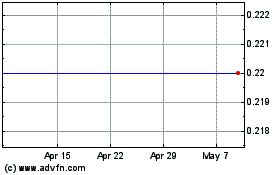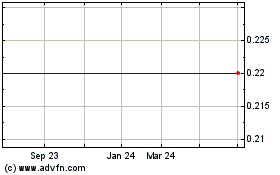RMIT Study- CFCL Fuel Cell Future Clean Energy
May 03 2011 - 2:02AM
RNS Non-Regulatory
TIDMCFU
Ceramic Fuel Cells Limited
03 May 2011
Ceramic Fuel Cells' fuel cell technology a "clean technology
option for the future" - RMIT University study
Monday 2 May 2011
Ceramic Fuel Cells' solid oxide fuel cells can deliver
significant benefits in electricity production and carbon reduction
to thousands of Australian buildings, a team at RMIT University's
Centre for Design has found.
The high quality of power and reliability of electricity
generated from fuel cells - which can deliver electricity without
large surges, spikes and outages - mean they have great potential
in industries like banking, data centres, grocery chains and
storage facilities. Fuel cells are also cost-efficient alternatives
to batteries in serving as back-up power systems.
Deepak Sivaraman, Simon Lockrey and Andrew Carre - authors of
Potential Opportunities for Increased Fuel Cell Deployment in
Australia: A Ceramic Fuel Cell Case Study - determined that Ceramic
Fuel Cells' technology could be utilized in many ways to either aid
buildings earn energy and low carbon accreditation or comply with
new, green building codes.
Over the past decade in Australia electricity demand increased
at an annual average rate of 2.7%. Each year in Australia around
200 million tonnes of carbon dioxide is released into the
atmosphere from electricity and heat production from non-renewable
resources.
According to the RMIT report, the transition to a low carbon
electricity sector in the future is "very necessary", and can be
achieved using both renewable and low carbon technologies.
"The solid oxide fuel cell technology manufactured by Ceramic
Fuel Cells Limited (CFCL) is a clean technology option for the ...
future," the report says. "Ceramic Fuel Cells Limited (CFCL) is a
global pioneer in manufacturing solid oxide fuel cell technology.
It is a co-generation system: it has the flexibility to generate
different amounts of electricity and heat from natural gas
inputs."
The paper explores the following federal and state regulatory
structures, which cover a variety of buildings including homes,
offices, hotels, retail outlets, schools, libraries and
hospitals.
-- National Australia Built Environment Rating System
(NABERS)
-- Green Building Council of Australia; Green Star Rating
Tool
-- Australian Building Codes Board: Alternate Energy Supply for
Hot Water
-- New South Wales Energy Efficiency Scheme
-- Green Star Public Building Pilot Tool
-- NSW BASIX Program
The RMIT paper explains that the NABERS and Green Star Rating
system (Green Building Council of Australia) awards higher ratings
to the buildings based on the difference in carbon intensity
between onsite fuel cell generation and grid electricity
generation.
The authors recommend that states with more carbon-intensive
electricity grids such as Queensland, New South Wales, Western
Australia and Victoria be targeted for fuel cell deployment. Under
the NABERS scheme a typical commercial building using high
efficiency fuel cells to produce 100% of its electricity needs will
obtain a five-star rating - the highest possible (the study example
uses a 100 m(2) 'market average performing' commercial building, or
2.5 stars on grid electricity, in NSW).
The report also concludes that solid oxide fuel cells can also
be used under the New South Wales Energy Efficiency Scheme and NSW
BASIX Program to create greenhouse gas abatement certificates. In
the case of the New South Wales Energy Efficiency Scheme these
certificates can be sold for a market price. Under the NSW BASIX
Program the fuel cell technology can be utilized to comply with
state regulations - in both new and existing buildings.
Similarly, the technology can also be used to supply hot water
to different types of buildings under the Australian building code
framework. The latest Green Star Public Buildings Tool makes a
provision for low carbon technologies to be utilized, enabling
buildings to earn credit points through reducing greenhouse gas
emissions.
The RMIT report is available at www.cfcl.com.au
For further information please contact:
Ceramic Fuel Cells
Andrew Neilson Tel: +613 9554 2300
Email: investor@cfcl.com.au
Australia Media enquiries Tel: +613 9915 6341
Richard Allen, Oxygen Financial Public
Relations
About Ceramic Fuel Cells Limited:
Ceramic Fuel Cells Limited is a world leader in developing fuel
cell technology to provide highly efficient and low-emission
electricity from widely available natural gas. Ceramic Fuel Cells
is developing fully integrated power and heating products with
leading energy companies E.ON UK in the United Kingdom, GdF Suez in
France and EWE in Germany.
Ceramic Fuel Cells has sold more than 60 BlueGen
gas-to-electricity generators to major utilities and other
foundation customers in Germany, the United Kingdom, Switzerland,
The Netherlands, Italy, Japan, Australia and the USA.
Ceramic Fuel Cells is listed on the London Stock Exchange AIM
market and the Australian Securities Exchange (code CFU).
www.cfcl.com.au
This information is provided by RNS
The company news service from the London Stock Exchange
END
NRALIFEIETIFIIL
Ceramic Fuel Cells (LSE:CFU)
Historical Stock Chart
From Mar 2024 to Apr 2024

Ceramic Fuel Cells (LSE:CFU)
Historical Stock Chart
From Apr 2023 to Apr 2024
